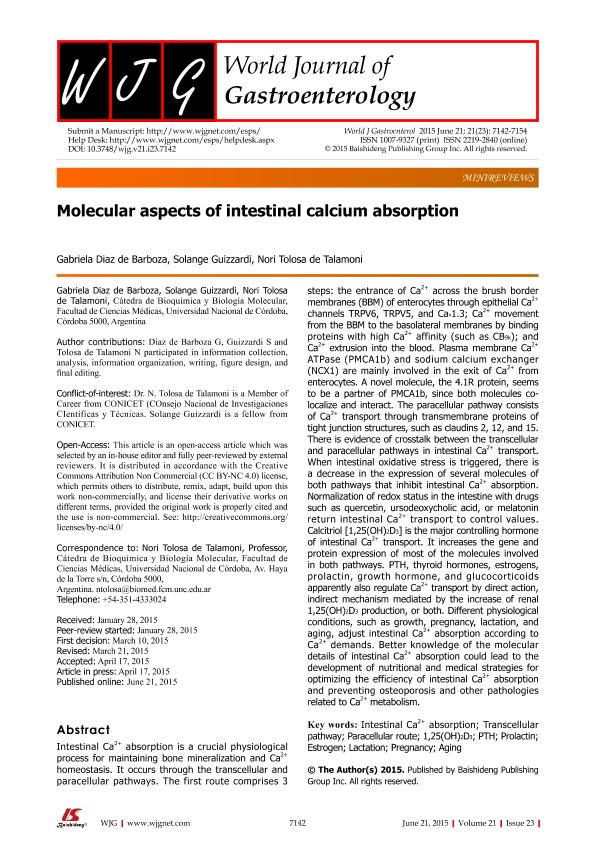Artículo
Molecular aspects of intestinal calcium absorption
Fecha de publicación:
06/2015
Editorial:
W J G Press
Revista:
World Journal Of Gastroenterology
ISSN:
1007-9327
e-ISSN:
2219-2840
Idioma:
Inglés
Tipo de recurso:
Artículo publicado
Clasificación temática:
Resumen
Intestinal Ca2+ absorption is a crucial physiological process for maintaining bone mineralization and Ca2+ homeostasis. It occurs through the transcellular and paracellular pathways. The first route comprises 3 steps: the entrance of Ca2+ across the brush border membranes (BBM) of enterocytes through epithelial Ca2+ channels TRPV6, TRPV5, and Cav1.3; Ca2+ movement from the BBM to the basolateral membranes by binding proteins with high Ca2+ affinity (such as CB9k); and Ca2+ extrusion into the blood. Plasma membrane Ca2+ ATPase (PMCA1b) and sodium calcium exchanger (NCX1) are mainly involved in the exit of Ca2+ from enterocytes. A novel molecule, the 4.1R protein, seems to be a partner of PMCA1b, since both molecules colocalize and interact. The paracellular pathway consists of Ca2+ transport through transmembrane proteins of tight junction structures, such as claudins 2, 12, and 15. There is evidence of crosstalk between the transcellular and paracellular pathways in intestinal Ca2+ transport. When intestinal oxidative stress is triggered, there is a decrease in the expression of several molecules of both pathways that inhibit intestinal Ca2+ absorption. Normalization of redox status in the intestine with drugs such as quercetin, ursodeoxycholic acid, or melatonin return intestinal Ca2+ transport to control values. Calcitriol [1,25(OH)2D3] is the major controlling hormone of intestinal Ca2+ transport. It increases the gene and protein expression of most of the molecules involved in both pathways. PTH, thyroid hormones, estrogens, prolactin, growth hormone, and glucocorticoids apparently also regulate Ca2+ transport by direct action, indirect mechanism mediated by the increase of renal 1,25(OH)2D3 production, or both. Different physiological conditions, such as growth, pregnancy, lactation, and aging, adjust intestinal Ca2+ absorption according to Ca2+ demands. Better knowledge of the molecular details of intestinal Ca2+ absorption could lead to the development of nutritional and medical strategies for optimizing the efficiency of intestinal Ca2+ absorption and preventing osteoporosis and other pathologies related to Ca2+ metabolism.
Palabras clave:
Intestinal Calcium Absorption
,
Transcellular Pathway
,
1,25(Oh)2d3
,
Pth
Archivos asociados
Licencia
Identificadores
Colecciones
Articulos(INICSA)
Articulos de INSTITUTO DE INVESTIGACIONES EN CIENCIAS DE LA SALUD
Articulos de INSTITUTO DE INVESTIGACIONES EN CIENCIAS DE LA SALUD
Citación
Díaz de Barboza, Gabriela; Guizzardi, Solange Natali; Tolosa, Nori Graciela; Molecular aspects of intestinal calcium absorption; W J G Press; World Journal Of Gastroenterology; 21; 23; 6-2015; 7142-7154
Compartir




